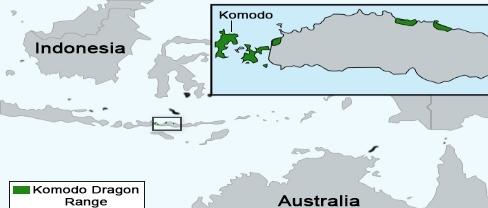Taxonomy
The Komodo dragon (common name) is the heaviest carnivorous lizard on the planet listed in the IUCN red list as vulnerable. The species is scientifically known as Varanus komodoensis. It is endangered due to the loss of habitat and prey.
Habitat Requirements and Range
The species is endemic to Indonesia’s Lesser Sunda Islands that constitute a volcanic arc. Komodo dragons thrive in extreme heat (above 35 degrees Celsius) and 70-percent humidity – terrestrial and marine environments (San Diego Zoo Global). These conditions are characteristic of the five Indonesian islands that have been their habitat for millions of years. The areas are rocky and mountainous (800m above sea level) with vegetation ranging from tropical dry forest to savannah grasslands (Jessop et al. 1). The current geographical range of this species is the Komodo National Park and Flores Island (8°35′22″ S, 119°36′52″ E) (Figure 1).

Trophic Relations
The species is an apex predator. Komodo dragons are opportunistic carnivores with a broad prey range. The mostly arboreal hatchlings consume insects and birds, while adult animals feed on rodents and ungulates like wild boar, buffalo and deer (San Diego Zoo Global). Komodo dragons use venom in their saliva to kill large prey.
Life History Characteristics
Komodo dragons have complex reproduction and development. The species attains sexual maturity after 5-7 years and females lay 1-30 fertilized eggs after every two years in an underground nest (San Diego Zoo Global). The incubation period is 3-8 months depending on temperature and longevity is about 30 years (San Diego Zoo Global). Hatchlings are arboreal. The longer generation times, delayed maturity and longer life span make Komodo dragons K-strategists.
Land/Ocean Habitat
The species occurs mostly in the protected islands that form the Komodo National Park. Based on the capture-recapture method, Purwandana et al. estimated the dragon density across 10 sites to be 4-22 individuals per km2 (1064). Thus, each animal would require a land habitat of 0.046-0.25km2.
Minimum Viable Population Size
The Komodo National Park was established to preserve the survival of the endangered Komodo dragons. The minimum viable population (MVP) size of this species is 15,283 adult individuals (Purwandana et al. 1062). The slower sexual maturity and low survival rate of hatchlings account for the high MVP estimate.
Primary Uses
Komodo dragons in protected ecotourism, a source of income for Indonesia. Their blood contains antimicrobial proteins that have potential as a therapeutic agent for humans (San Diego Zoo Global). However, habitat loss is a major threat to the survival of this species.
Population Sizes and Endangered Status
The number of Komodo dragons has declined in recent years. Currently, only about 5,700 individuals exist in the five islands of Indonesia: 2,450 in the Komodo National Park, 1,185 in Rinca Island, 100 in Flores Island and 2000 dispersed in unprotected areas (Jessop et al. 5). As a result, the IUCN lists Komodo dragons as vulnerable – not endangered but facing a high extinction risk.
Current Threats
The Komodo dragon is threatened by human activity. Habitat destruction due to deforestation and forest fires and loss of prey caused by increased poaching of deer remain challenges to the species’ survival (Jessop et al. 8). Volcanic activity in the islands also destroys vegetation and game. The geographical restriction of endemic populations to specific areas causes inbreeding.
Management Recommendations
Reducing human threats to the species survival will require the following proposals:
- Banning logging in the islands and afforestation programs to increase ungulate prey populations, including deer and water buffaloes, in the habitat
- Reducing eco-tourism activities that require the animals to be restricted to specific areas – this action will promote outbreeding and genetic diversity to reduce susceptibility to disease
Fun Fact
For a long time, Komodo dragons have been known to stalk and kill large prey. A fun fact about these amazing animals is that they cannot see or hear. They make up for these limitations by having a strong sense of smell. Their forked tongue can pick up a scent of a carcass from up to ten miles away!
Works Cited
Jessop, Tim, et al. “Exploring Mechanisms and Origins of Reduced Dispersal in Island Komodo Dragons.” Proceedings of the Royal Society B, vol. 285, 2018, pp. 1-10.
Purwandani, Deni, et al. “Evaluating Environmental, Demographic and Genetic Effects on Population-Level Survival in an Island Endemic.” Ecography, vol. 3, 2015, pp. 1060-1070.
San Diego Zoo Global. “Komodo Dragon (Varanus komodoensis) Fact Sheet.” Web.